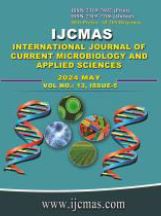


 National Academy of Agricultural Sciences (NAAS)
National Academy of Agricultural Sciences (NAAS)

|
PRINT ISSN : 2319-7692
Online ISSN : 2319-7706 Issues : 12 per year Publisher : Excellent Publishers Email : editorijcmas@gmail.com / submit@ijcmas.com Editor-in-chief: Dr.M.Prakash Index Copernicus ICV 2018: 95.39 NAAS RATING 2020: 5.38 |
Slender Loris is mainly distributed in Andhra Pradesh, Karnataka and Tamil Nadu, India, whereas Slow Loris is distributed over south of Brahmaputra River in north-eastern India. They are regarded as endangered and vulnerable respectively owing to various anthropogenic activities such as loss of forest cover and habitat destruction, poaching and hunting for illegal trade and superstitions. Skin, claws, teeth, bones, meat, and other derivatives of these species, even whole live animals are often seized by enforcement agencies from illegal traders. But it is difficult to identify the small parts of skin or its derivatives with the conventional morpho-taxonomic methods. So, easy, quick and reliable parameters are needed to identify skin and its derivatives for prosecution of persons engaged in illegal trade of wildlife. Tricho-taxonomic study of dorsal guard hairs provides good result for identifying the small parts of skin and its derivatives.
Alfred, J R B., Sinha, N K., and Chakraborty, S. Checklist of Mammals of India. Records of the Zoological Survey of India, Occasional Paper, 2002, 199:1-289. Pub. Director, Zoological Survey of India, Kolkata. https://cir.nii.ac.jp/crid/1130282269781883904
Bahuguna, A. Identification of Indian Species of Callosciurus Gray, through dorsal guard hair (Mammalia: Rodentia: Sciuridae). Biosystematica, 2008,1(2):25-32.
Bahuguna, A. Trichotaxonomy of Indian species of Genus Ratufa Gray (Mammalia:Rodentia: Sciuridae). Records of the Zoological Survey of India, 2010,110(3):37-57.
Bahuguna, A. Trichotaxonomy of Red giant flying squirrel, Petaurista petaurista (Pallas) and Northern palm squirrel, Funambulus pennanti (Wroughton) (Mammalia: Rodentia: Sciuridae). Annals of Forestry, 2007,15(2):58-69.
Bahuguna, A., and C, Radhakrishnan. Comparative study of the Characteristic features of primary guard hair of Malabar civet, Vivera megaspillacivetina Blyth, 1862, (Mammalia: Carnivora: Viverridae) with other Indian Viverrids. Biosystematica, 2010, 4(2):19-28.
Brunner, H., and B, Coman. The identification of mammalian hair. Inkata Press, Victoria, Australia, 1974:196.
De, J K., and Chakraborty, R. Identification of dorsal guard hairs of striped Hyena, Hyaena hyaena (Linnaeus, 1758) (Hyaenidae: Carnivora: Mammalia). The Journal of the Bombay Natural History Society, 2002,99(3):502-506. https://biostor.org/reference/152089
Chakraborty, R., and De, J K. Atlas on Hairs of Indian Mammals. Part I: Carnivora, Zoological Survey of India, 2010:1-141.
De, J K., and Chakraborty, R. Structure and pattern of guard hairs of crab eating mongoose, Herpestes urva (Hodgson) (Mammalia: Carnivora: Herpestidae) Proceeding of the Zoological Society, Calcutta 48, 1998,48:33-36.
De, J K. Study of Surface structure of hair of some Primates of Indian Subcontinent. Records of the Zoological Survey of India, 1993:31-34. https://doi.org/10.26515/rzsi/v93/i1-2/1993/160859
De, J K., and Chakraborty, R. Identification of dorsal guard hairs of four Indian species of Bear (Mammalia: Carnivora: Ursidae). Records of the Zoological Survey of India, 2006,106(3):19-26. https://doi.org/10.26515/rzsi/v106/i3/2006/159187
Hausman, L A. Structural characteristics of the hair of mammals. The American Naturalist 54, 1920:496-523. http://www.jstor.org/stable/2456345.
Homan, J A., and Genoways, H H. An analysis of hair structure and its phylogenetic implications among heteromyid rodents. Journal of Mammalogy, 1978, 59:740-760. https://doi.org/10.2307/1380139
Kamalakannan, M. Comparative hair morphology of the giant flying squirrels Petaurista petaurista, Petaurista magnificus and Petaurista philippensis (Sciuridae: Rodentia: Mammalia). Journal of Entomology and Zoology Studies, 2017, 5(3):84-86. https://api.semanticscholar.org/CorpusID:53953294
Kamalakannan, M., De, J K., and Manna, C K. Tricho-taxonomic studies of dorsal guard hairs of Indian Cervids (Artiodactyla: Mammalia) for species identification. Biolife, 2015, 3(2). :547-552 https://dx.doi.org/10.5281/zenodo.7270337
Koppiker, B R., and Sabnis J H. Further studies on the identification of hairs of some Indian mammals. The Journal of the Bombay Natural History Society, 1977, 74:50-59. https://biostor.org/reference/148144
Koppiker, B R., and Sabnis, J H. Identification of hairs of some Indian mammals. The Journal of the Bombay Natural History Society, 1976,73:5-20. https://biostor.org/reference/148424
Molur, S D., Brandon-Jones, W., Dittus, A., Eudey, A., Kumar, M., Singh, M M., Feeroz, M., Chalise, P P., and Walker, S. Status of South Asian Primates: Conservation Assessment and Management Plan Report. Workshop Report, 2003. Zoo Outreach Organization /CBSG-South Asia, Coimbatore, India.
Moore, T D., Spence, L E., and Dugnolle, E E. Identification of the dorsal guard hairs of some mammals of Wyoming. Wyoming Game and Fish Department, 1974, 14:177.
Nekaris, A., and U, Streicher. "Nycticebus coucang". The IUCN Red List of Threatened Species. IUCN. 2008: e.T39759A10263403.
Prater, S H. The book of Indian Animals. 3rd Ed. Bombay Natural History Society, Oxford University Press. Bombay, 1971, 1-324. ISBN: 9780195621693
Ridgway, R. Nomenclature of Colours. Univ. Press, John Wilson and Son, Cambridge, 1886, 129. https://doi.org/10.5962/bhl.title.61104
Sahajpal, V., Goyal, S P., Jayapal, R., Yoganand, K., and Thakar, M K. Hair characteristics of four Indian bear species Science and justice: journal of the Forensic Science Society, 2008, 48(1): 8-15. https://doi.org/10.1016/j.scijus.2007.05.001
Sarkar, P S., and De, J K. Identification and study of Dorsal Guard hairs of the species belonging to Family-Hystricidae (Rodentia: Mammalia). Uttar Pradesh Journal of Zoology, 2019, 40(4):222-229. http://journal.edit4journal.com/id/eprint/2073
Sarkar, P S., and De, J K. Surface Structure of Dorsal Guard hair of Gibbon (Hylobates hoolock: Primate: Mammalia). Knowledge (e-journal) 1(1), Pub: Vivekananda College for Women, Kolkata, West Bengal, India, 2016.
Sarkar, P S., and De, J K. Tricho-taxonomic study of dorsal guard Hairs of Indian species of Rodentia belonging to Sub-family Sciurinae (Sciuiridae:Rodentia: Mammalia) Biological Forum-An International Journal, 2013, 5(1):1-190.
Sarkar, P S., De, J K., and Manna, C K. Identification of Dorsal Guard Hair of Seven Species of the Family Cercopithecidae (Primates: Mammalia). Proceedings of the Zoological Society, 2010, 63(2): 121-128. https://doi.org/10.1007/s12595-010-0017-1
Sarkar, P S., De, J K., and Manna, C K. Identification of dorsal guard hairs of five species of the family Cercopithecidae (Primates: Mammalia). Current Science, 2011,100(11):1725-1728.
Stangyl, F B Jr., and Grimes, J V. Phylogenetic implications of comparative pelage morphology in Aplodontidae and the Neartic Sciuridae, with observations on seasonal pelage variation. Occasional Paper, The Museum, Texas Tech University, 1987, 112: 1-21. https://doi.org/10.5962/bhl.title.156560
Teerink, B J. Hairs of West European Mammals. Cambridge University Press, Cambridge. 1991, 223.
 |
 |
 |
 |
 |